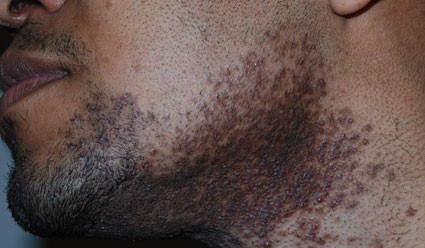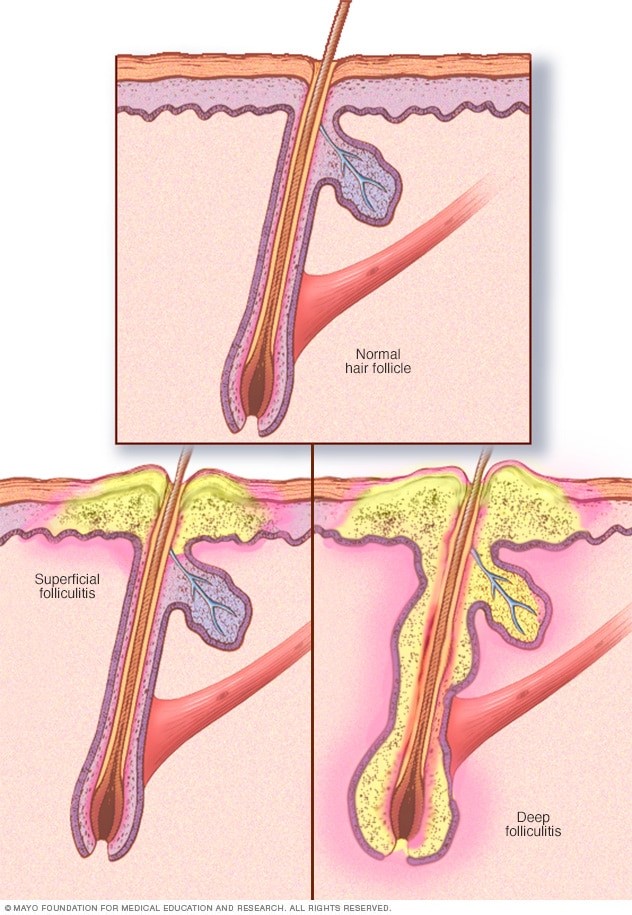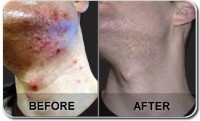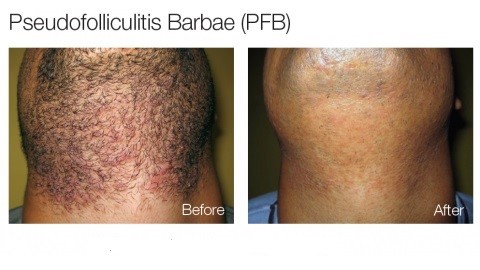Difference Between Sycosis Barbae And Pseudofolliculitis Barbae
Sycosis Barbae
This is an infection of the hair follicles in the chin or bearded region in men. This infection is caused by the Staphylococcus pyogenesaureus and leads to inflammation and irritation, erythematous and painful pustules and papules to form in the beards. These ‘small pimples’ makes shaving difficult because sometimes they break out with bloodstains. The infection usually affects the superficial parts of the hair follicles but sometimes it can be deeper and affect deeper parts of the follicles and maybe lead to scarring.
Pseudofolliculitis Barbae

Pseudofolliculitis Barbae is a condition caused by shaving. When someone shaves, the hair grows back and sometimes, for people with curly hair, the hair curls and goes back into the skin causing irritation and inflammation. This means that Pseudofolliculitis Barbae occurs when there is an ingrown hair.
There are two types of ingrown hairs: transfollicular and extrafollicular. While extrafollicular hair is a hair that has left the follicle and afterward reappeared on the skin, transfollicular hair doesn’t leave the follicle, but instead, it twists once more into the follicle in view of its wavy nature, prompting liquid to develop and therefore aggravation of the skin.
This infection is most common in the face but can also occur in other areas of the body where the hair is grown and shaved especially where the skin is sensitive and tender like the pubic area. If this occurs in the pubic area, it is called Pseudofolliculitispubis or PFP. Pseudofolliculitis Barbae is also called barber’s itch, shave bumps, razor bumps, scarring pseudofolliculitis of the beard and folliculitis barbae traumatic.
Severe cases of Pseudofolliculitis Barbae and improper treatment of it can lead to scarring and sometimes keloid formation.
Differences between Sycosis Barbae and Pseudofolliculitis Barbae
The difference between Sycosis Barbae and Pseudofolliculitis Barbae is the cause of the inflammation in the hair follicles. While Sycosis Barbae is caused by infection of hair follicles, often by species of Staphylococcus pyogenesaureus, Pseudofolliculitis Barbae is caused by irritation from shaving and ingrown hairs.
More on the Causes of Sycosis Barbae

Although Sycosis Barbae is a staphylococcal infection, the condition can also be triggered by the use of blunt razor blades, unsterilized shaving tools, poor hygiene of the barber and even the individual’s skin condition. In other words, the presence of all these can cause one to have the infection.
A possible cause of this condition is the constant use of a blunt razor blade in shaving. The use of blunt razor affects the skin in the bearded area in that it forcefully takes out the hair thereby irritating the underlying skin.
The use of unsterilized shaving equipment is precipitate the condition because the acquired dirt and harmful elements on the razor or clipper are transferred to the skin and when the skin reacts to them, it can lead to itching and even more severe situation.
Lack of hygiene by barbers is another possible cause of this malady. They use the same clipper on several clients without taking out time to clean it. Some do not even take care of their hands or wash them once in a while as they work. So when they put their unclean hands and contaminated scissors on the substance of their customers, they open their skins to assault.
Skin sensitivity can make one prone to infection. Some people already have very sensitive skins that are defenseless and easily affected by harmful elements thereby making them open to the infection than others whose skins are not as sensitive and vulnerable.
More Details on the Causes of Pseudofolliculitis Barbae

Over the years, it has been observed that Pseudofolliculitis Barbae is more common among men with tightly curled hair; that is to say, men from ethnic groups that are predisposed to coiled hair are more likely to experience the condition. African American men 45% to 85% from research, and also women, may suffer from the condition more than others who are not.
Unfavourable shaving method is another cause of Pseudofolliculitis Barbae. Being that the African hair follicle is curled, shaving against the direction can precipitate the condition.
How to Prevent Sycosis Barbae
Maintaining good hygiene. Constant treatment of shaving tools like razors and clippers. Whether an individual goes to the barbing salon to shave or does it by himself in his house, the tools must be properly treated, sterilized and kept away from dust and other harmful external elements.
Have your own grooming tools. Make use of the shaving stick once and discard at a strategic distance from contaminations. Some people do make sure they clean their equipment once they finish using but to be on a safe side, the shaving stick should be used once and disposed of.
For those who do not shave their beards by themselves, get your own grooming equipment as well and take them along with you when going to the barber.
After use, make sure that they are sterilized very well before you keep them.
Whenever you notice any anomaly, do well to seek proper medical counseling and checkup. This disease develops gradually and the first sign of it is very painful pimples and whether you pinch it or not it does not make any difference, it won’t go away. So, nothing is inconsequential; the slightest of sensation or spot should not be overlooked as it may turn out to be a nasty papule or a pustule. One importance of seeking medical advice early is that it enables early detection of the infection and consequently early treatment which goes a long way in boosting the healing process and avoiding scars that usually occur from severe cases.
Also, avoid working in overheated and ill-ventilated areas as this may trigger the infection.
How to Prevent Pseudofolliculitis Barbae
The best way to avoid the situation is to grow a beard. This way, the curly hairs are prevented from growing back into the skin. For people who do not like long beards, leaving it short and above skin level is a good option.
Shaving razors should be changed as frequently as possible and people should invest more in electric clippers and razors.
Constantly combing as often as possible daily will help to straighten out the hair to a good extent and this help in preventing ingrowths.
Proper and healthy hair removal and shaving method is a sure way of avoiding the occurrence of the condition.
Normally, for people with curly hair, the initial growth of the beard is parallel to the skin and shaving obliquely with a razor produces a sharp tip which aids extrafollicular penetration. In other words, shaving should be done in the direction of hair growth rather than in the opposite direction.
The kind of shaving cream one uses can also contribute to the possibility of having this condition. It is advisable for men to use non-irritating shaving cream while shaving. This will help to protect sensitive skins.
While shaving, pulling the skin should be avoided; do not exert too much pressure on the skin.
Treatment of Sycosis Barbae

Most people who suffer from this infection are people who shave irregularly, and that is why a healthy grooming routine is of utmost importance in preventing this and other infections and also in managing and treating it in the case of an eventuality. So, one effective way of treating this infection is regular shaving because, according to some specialists, those who shave daily and those who do not shave at all, rarely suffer from the barbers’ rash.
However, some men and specialists think that shaving too often can make one vulnerable to having this infection. This, according to them, is why this condition is quite common among military men compared to men in other fields where men are allowed to grow beards, if they so desire, without any restrictions whatsoever. What is most important is that you understand yourself and know what excites or irritates your skin and take care of it accordingly.
The use of sharp shaving tool, be it a razor or a clipper can help the healing process. Using a blunt razor can aggravate the situation especially as the skin is already inflamed.
The use of antiseptic lotion is also important. It should be generously dabbed on and left to dry; it will aid the eradication of the infection from the follicles.
Also, the patient must seek medical help. This recalcitrant staphylococcal infection is very difficult to treat, even though it affects the surface parts of the hair follicles, so you do not want to make things worse by boycotting necessary treatments. Conditions like this (and other medical conditions) are not what quacks should handle; an expert has to come in and do his/her job to avoid improper treatment which may result in a chronic version of the infection.
The condition can also become chronic if the pus from pustules or septic infection discharges externally and touches the beards thereby re-infecting it. The discharges can be prevented from touching the beards by dabbing it off gently without hurting the already inflamed and tender skin. Also, boils, fissures at sides of the mouth, infective lesions in the nose, ears, gum, etc can contribute to making the situation worse. So, for a proper and total cure to take place, all other maladies and infections must be properly resolved.
The patient must ensure that he shaves off his beards completely when undergoing the treatment of Sycosis Barbae to ensure proper treatment of the affected area, although doctor’s recommendation is of utmost importance and overrides other prescriptions. If the doctor permits complete shaving, the patient should endeavor to do this carefully so as to avoid cutting the pustules and spreading the pus, and consequently the infection, to other areas of the face.
- Best Beard Kits for African Americans
- All you need to know on Peppermint oil
- List of 13 Best Wedding Beard Styles
- Tips on How Beard Can be Decorated This Christmas
- How Often Should You Trim Your Hair
Also, while undergoing treatment, the patient must ensure that he completes the process to avoid a resurgence of the condition and possibly scarring.
Treatment of Pseudofolliculitis Barbae

Growing a beard is a way to prevent the occurrence of this condition given the fact that it is caused by an ingrown hair. If the curly beard is long, it prevents it going back into the skin. Irrespective of this, there are also ways of helping and already-occurred situation.
Dirt and dead skin cell should be exfoliated from the affected skin area to open the pores. This will help the healing process. To do this, the patient should get an exfoliator, like benzoyl peroxides, glycolic or salicylic acids, or retinoids, and apply it to the affected area for a few minutes and rinse off with warm water.
Aloe vera has been found to have an antibacterial, soothing, anti-inflammatory and also moisturizing effect. When applied, it helps to stop itchiness, inflammation, and redness caused by the razor bumps within a short while.
Pseudo BarBae Natural Medicated Organic Leave-in Conditioner 8 oz. by Pseudo…
The patient should extract the gel from the aloe leaves and apply it to the affected spot. It should be left on to dry for about thirty minutes. This process should be repeated for a few times daily.
There are antibacterial lotions that doctors can prescribe or can be bought in pharmacies to help in treating the condition.
There are also steroid creams that can be used as recommended by a doctor or simply bought.
Learn How To Fight Pseudofolliculitis Barbae: Shaving Bumps & Ingrown Hairs
Sycosis Barbea is an infection of the hair follicles caused by Staphylococcus pyogenesaureus which produces inflammation leading to the formation of an abscess in the follicle. The infection is usually superficial but sometimes it can be deeper and affect deeper parts of the follicles which may lead to scarring. Pseudofolliculitis Barbae, on the other hand, is an irritation of the skin caused by shaving and ingrown hair.
Several preventive measures can be taken to avoid or reduce the chances of having the condition of Sycosisbarbaesuch as getting personal shaving equipment and not sharing them, seeking medical advice whenever an anomaly is noticed, avoiding working in ill-ventilated and overheated areas and, very importantly, maintaining a healthy personal hygiene.
Pseudofolliculitis barbae can be prevented by growing a beard but for those who do not like to keep beards, proper hair removal and shaving methods are very much needed to keep the situation at bay. For treatment, patients should seek the help of an expert medical practitioner.
Frequently Asked Questions and Answers on Difference Between Sycosis Barbae And Pseudofolliculitis Barbae
Is syscois Barbae contagious?
Most of the folliculitis is known to be curable…Although most folliculitis is not contagious, they are caused by infectious agents that transmit them through person-person skin, shared razors, hot tubs or Jacuzzis.
Is folliculitis contagious sexually?
As said earlier, most types of folliculitis aren’t contagious. However, in some cases, if an infectious agent like razors causes the folliculitis to get transferred. It can also spread via skin-to-skin contact.
How do you stop folliculitis from spreading?
To stop folliculitis from spreading do the following:
- Take your bath or shower daily with a mild soap.
- Don’t share your towel, washcloths or personal items.
- Don’t scratch the bumps.
- Stop using beard oils on your skin.
What happens if you leave folliculitis(sycosis barbae) untreated?
Leaving folliculitis untreated for a specific period of time can lead to furunculosis, and may also lead to cellulitis(more severe inflammation of the skin).
Can folliculitis leave scars?
Moderate and mild cases of folliculitis don’t leave scars with proper treatment.
Does pseudofolliculitis barbae go away?
In most cases, avoiding shaving of the beard for 3-4 weeks allows all lesions to subside, and most extrafollicular hairs will resolve themselves within ten days. Shaving in the direction of hair growth on other days, instead of daily may improve the situation.
How do you prevent pseudofolliculitis barbae?
To prevent pseudofolliculitis barbae:
- Avoid shaving your beard too closely
- Make sure you shave in the direction of hair growth rather than “against the grain”
- Make use of electric razor
- Don’t pull hair when shaving
- Replace your razor frequently
Conclusion on Difference Between Sycosis Barbae And Pseudofolliculitis Barbae
We have discussed the difference between Sycosis Barbae and Pseudofolliculitis Barbae, how the two can be prevented, caused of Sycosis Barbae, causes of Pseudofolliculitis Barbae, and we have also provided answers to how the re-occurrence of the two can be prevented, how to stop folliculitis from spreading, is folliculitis contagious. If you have anything to ask or contributions you want to make kindly make use of the comment box.
